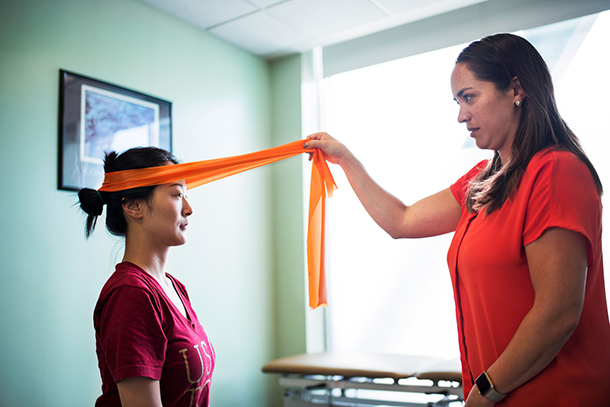For years, Noya Wang has struggled with headaches.
The pain would radiate from the back of her head and was often accompanied by neck and shoulder pain.
“Some days are better than others, and sometimes it’s more in the head, and others it’s more in the neck,” she said. “In general, I feel really tense in the neck area, and the back of my head its always achy.”
The headaches were making her unhappy. Though they didn’t often interfere with daily activities, the headaches did add a patina of pain to everything she did. On bad days though, Wang wasn’t able to hold her head straight and only felt better when she lied down.
Desperate for relief, she tried a variety of treatments, including medication, massage and acupuncture, but all to no avail.
Headache relief: remarkable results
In 2015, she found her way to Erica Sigman, DPT, instructor of clinical physical therapy in the USC Division of Biokinesiology and Physical Therapy, who also treats patients with headache and jaw pain at the division’s faculty practice.
USC Physical Therapy (formerly PT Associates) offers a headache management program on both the University Park and Health Sciences campuses, in which board-certified neurologic and orthopaedic physical therapists work alongside specialists from the USC Headache and Neuralgia Center to create individualized treatment programs for headache sufferers.
While physical therapy is more likely to be associated with therapy for knees rather than heads, it’s gaining recognition as a treatment for headaches, Sigman said.
Medical histories
The process begins with a medical history evaluation as well as a thorough assessment, which serve as the basis for a comprehensive evidence-based treatment plan.
During Wang’s first appointment, Sigman measured her range of motion, assessed the joints of her neck and checked the strength of her postural muscles.
Sigman said physical therapists have the unique ability to identify postural and cervical contributing factors to a patient’s headache. Once patients understand their triggers and postural factors, they can better prevent headaches from occurring.
During a therapy session, Sigman usually begins with manual therapy to the thoracic spine.
“That’s a safe place to start,” she said. “Then I might look and see if the patient presents with myofascial trigger points because those can refer pain to the head.”
Sigman will use manual therapy, ice massage and/or cupping to work on those trigger points. She then might work her way down the cervical spine, at times with manual therapy, but always working to strengthen the deep neck muscles. As with any physical therapy, she gives the patient at-home exercises to do between sessions.
The results were remarkable, said Wang, whose treatment consisted of manual physical therapy, exercise and the use of heat and ice.
“With every therapy, my baseline pain has gotten better,” she said. “It’s one of the most effective things I’ve tried for my headache.”
Fewer pill bottles
With most cervicogenic headaches — pain that is referred from the cervical spine and surrounding soft tissues — the headache goes away within three months of treatment. But it really depends on the patient — if they have chronic or episodic migraines, they may need ongoing treatment.
That’s the case with Brooke Woodfield, another of Sigman’s patients. Woodfield has chronic migraines and seizure disorder. She had been on many medications with not much relief and was missing social and family events due to pain.
Woodfield, who works as an occupational therapist, said she was initially skeptical that physical therapy would help her headaches. But one day, she went to see Sigman with a really bad headache. By the time she left, the headache was gone and she didn’t need medication.
“Dr. Sigman validated I do have trigger points for my headaches,” Woodfield said. “People told me I was making it up or that ‘it wasn’t that bad.’ But she really validated it and as a result, I’m not taking as much medication. It’s been so helpful.”
In the session, Sigman does manual muscle massage. “I have trigger points and she works on those,” she said. “Then I do exercises, and I get ice at the end of my session.”
Beyond expectations
Wang said she notices a difference in how physical therapy feels, compared with other treatments she’s tried.
“I feel like this is the least invasive,” she said. “If you think about acupuncture, it’s pretty invasive. Physical therapy is even less invasive then massage: It’s very gentle and if you feel pain, they modify.”
Even though it’s gentle, she has found it to be the most effective treatment.
Sigman agrees: “Physical therapy for headaches isn’t a no-pain, no-gain situation,” she said. “You shouldn’t be uncomfortable, and if you do have head pain from the treatment, you should speak up.”
Looking back, Woodfield said she wished she had discovered physical therapy sooner.
“I didn’t realize how unwell I felt. I was doing just the minimum to get by. I had headaches every day and I thought it was normal.”
Instead of surviving, she’s now doing more activities and she doesn’t avoid family events for fear of pain. Instead of daily headaches, she can go two or three days without symptoms.
Wang said physical therapy at USC is her personal happy place.
“The care is beyond excellent. It’s way beyond my expectation. From the moment I walk in, people say hi to me and it’s full of love and energy. I can’t expect anything better than that.”
— Katharine Gammon


